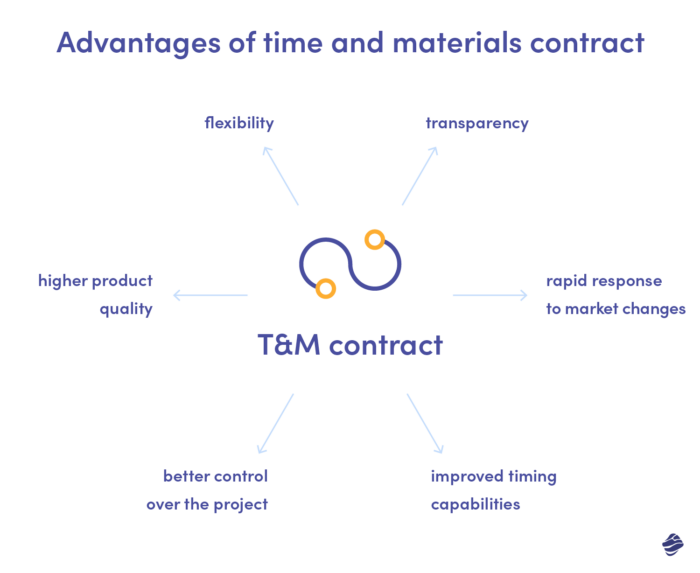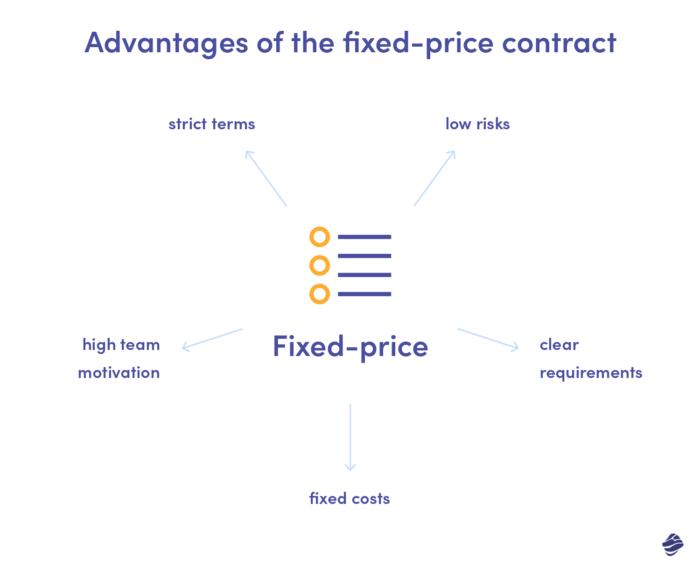So, you’re about to build your digital solution. You’ve probably already found some software development providers who stand ready to create an outstanding digital product for your business. Maybe you’ve even talked to their sales teams, who presented a more detailed offer. Did they mention at some point their preferred pricing contract? Here, software development companies commonly propose two of the most popular agreements: fixed-price or time and material.
If these two terms seem foreign to you and you’ve never heard them before, we’re here to clear up any doubts you may have.
This article will tell you everything you need to know about fixed-price and time and material contracts. We will indicate the benefits and drawbacks of each pricing model and help you find the answer to the most pressing question: Which one should you choose as the right pricing contract when selecting software engineering services?
Let’s cut to the chase!
What exactly is the time and material (T&M) contract?
In the time and material (T&M) agreement, the total cost is not determined at the beginning of the cooperation as it depends on the number of hours spent on the project and the materials used to deliver it.
Importantly, both parties agree on what materials will be used and on the hourly rate. So, even if the project takes much longer or much less time than anticipated, both parties can rest assured that they will be reimbursed and receive the work carried out or expected.
You need to keep in mind that the costs comprise not only the number of hours developers and designers spend on the project, but the contract includes meetings, communication, project management and other actions required.
Advantages of the time and material contracts
The time and material agreement is an excellent solution for many different reasons, such as:
- Improved timing capabilities and a thorough understanding of the project scope
- Regular communication throughout the entire project between the client and the service provider, which enables dynamic project management
- Flexibility within the project scope allowing for an evolving strategy to best suit the client’s needs
- Protection for both parties when paying for services
- Allows for ever-changing project requirements rapidly responding to current market demands and industry circumstances
- It supports an agile approach instead of a waterfall. The final product is usually of higher quality due to regular testing and modifying the project scope (if necessary).

Disadvantages of the time and material contracts
Even though the time and material model seems like a perfect solution in most cases, and we genuinely recommend it in our software development company, you need to be aware of some drawbacks of this type of contract. These are:
- Lower budget control. Since the final cost is not fixed and may change throughout the project, the costs may be higher than you initially anticipated.
- Uncertain project timeframe. Together with your service provider, you can set an expected deadline for the delivery of the project, but in reality, the timeframe may be much longer.
- Greater client involvement. For some, this may be a benefit, while for others a drawback. Since in the time and material model, the project’s scope may change over time, and features aren’t delivered simultaneously, this requires greater client involvement, more frequent communication and regulated feedback.
When to choose the time and material agreement
Are you wondering whether the time and material model will be the right option for you? Choose it especially when:
- You want to build a complex software solution where the development process can take months or even years.
- You don’t know the exact project scope, and you feel it may evolve.
- You want your digital solution to respond to ever-changing market needs and industry demands quickly.
- You can’t predict exactly how much labour is needed to develop and design the entire project.
Risk management in the time and material contract
Risk management in a time and material contract relies heavily on transparency and ongoing communication. Since costs can fluctuate based on hours worked and materials used, it’s crucial to maintain regular updates between the client and the service provider.
One way to mitigate risk is by establishing a clear budget framework or a cap to prevent runaway costs. Additionally, frequent progress reviews and sprint planning can help manage scope changes without derailing the project. Flexibility is key, but it should always be balanced with accountability to avoid unexpected financial strain. By setting realistic expectations and tracking progress closely, both sides can adapt to evolving project needs while keeping risks under control.
How does the time & material contract work in practice?
Unlike fixed-price contracts that nail down every detail, time and materials contracts are more flexible. They acknowledge that projects can evolve.
In practice, a time and material contract thrives on constant communication and collaboration. It’s an ongoing dialogue between the client and the contractor. Ideas flow freely, and the project’s direction can pivot with new insights and changing circumstances.
However, this adaptability doesn’t come without challenges. Clients might wonder if they’re getting their money’s worth without a fixed price tag. Here’s where transparency becomes crucial. Contractors need to be like an open book, showing their work, time, and expenses with impeccable clarity. It’s about building trust through radical honesty.
What is the fixed-price model?
In the fixed-price agreement, the client already knows the total cost for the entire project before it even begins. The initially set price should remain unchangeable throughout the project.
How does this work in practice? Let’s say you need a made-to-measure suit for your wedding. So you go to the tailor, and describe what you need: a classic grey suit with a white shirt and a patterned tie. You settle the agreement for your order on a fixed price, pay for it, and finally, the tailor can get to work. Seems like a pretty reasonable type of contract, right? You order a suit, know the exact price and the due date, so what could go wrong?
Imagine this situation. Two weeks pass, and you start thinking that maybe that classic suit wasn’t such a great choice after all. You go to the tailor again to change your order, but they refuse. You can’t blame them. After all, you agreed on a specific product, and the tailor has already invested some time and money in creating it. So what you can do in this situation is order a second suit. But that means extra costs on your side.
That’s how the fixed-price model works – you settle an agreement for a specific outcome that needs to be delivered on a predetermined date. But here, you also agree that you won’t introduce any changes in the project throughout the cooperation.
Advantages of the fixed-price contract
The fixed-price agreement is a highly popular form of contract for many different reasons:
- The final price is certain and won’t change. The buyer and the seller know the entire budget from the very beginning, which gives them stability and enables them to plan all the expenses.
- The deadline is established. In fixed-price contracts, not only is the budget set in advance, but the deadline for the delivery is also known and shouldn’t be missed.
- Everything is clear and transparent. With the specified total price and the deadline, you won’t have any unpleasant surprises.

Disadvantages of the fixed-price contract
The main drawbacks of this type of settlement come down to:
- Lack of flexibility. With the fixed fee contract, the time and budget needed to deliver the final product are known initially. In most cases, such agreements do not allow for any possible modifications during the project. Keep in mind that deciding everything in advance, when the project is in its infancy and ultimately at its least stable stage, means that fixed budget rates can actually limit the scope and flexibility of the project.
- Less client involvement. It may even be considered a benefit of fixed-price contracts in some cases. But let’s make some things clear: it’s always better to be involved in the development process, get regular reports on the workflow, and build a bond between you and your software provider. Only through mutual partnerships can the best results be achieved.
- Possible higher costs. Usually, higher predictability goes with a considerably higher price. In simple words, the seller needs to predict all the future costs and this involves substantial risk from their side. For that reason, they charge more in the case of a fluid price to have some backup. That’s why sometimes fixed-price projects may cost you much more than they should.
When to choose the fixed-price agreement
The fixed-price agreement might be the perfect solution for
- small or medium-sized projects with the limited project scope
- MVPs
- projects with well-established requirements that won’t change
- projects with a limited budget that can’t be exceeded
However, you must bear in mind that this type of settlement might not always be a reasonable choice. Try to avoid fixed-price contracts for long-term and highly advanced projects for one simple reason: here, you have much less control over the process.
Just think about it: you are ready to build a mobile application for your business with various more or less complex features. Can you estimate exactly how much time and money the whole development process will take? It is extremely tough to foresee all possible obstacles or development problems. What’s more, you might want to modify the project requirements after a while. Or maybe you’ll decide that you don’t need the one feature you had specified in the contract. Will this be possible if the final price and deadline are already set? Not exactly.
Risk management in the fixed price contract
Risk management in a fixed-price contract revolves around planning and strict adherence to the agreed scope of work. The key to success is thorough initial documentation, ensuring everything is clear before the project starts. Both parties must commit to the predefined budget and timeline, minimizing room for misinterpretation.
However, this approach can be risky if unforeseen changes arise mid-project, as alterations typically aren’t accounted for in the original agreement. Disputes over scope changes can lead to delays or additional costs, so it’s crucial to maintain clear communication. Building a contingency plan or incorporating buffer time into the timeline to mitigate these risks can help absorb unexpected challenges. Both parties should also ensure the contract has clear provisions for handling change requests efficiently.
How does the fixed-price model work in practice?
At its core, the fixed-price model relies on predictability and precision. The project’s scope is meticulously outlined, and a specific cost is agreed upon upfront. You agree on the price, you set the scope of work, and you’re all set.
In practice, this model can get a bit tricky. On one hand, it offers you a sense of security. You know the final bill and can plan budgets accordingly. However, the fixed-price model can be unforgiving when the unexpected arises. There can be disputes, change orders, and delays, which can strain relationships between clients and contractors.
To make it work, you need a solid plan and a commitment to sticking to it. Clear communication and documentation are essential.
Time and material vs fixed-price contract: a detailed comparison
Now you know what the fixed-price and time and material contracts are. But the question remains: Which of these pricing models will be a better choice for your next software project?
Let’s compare both approaches to make your decision much easier:
| Time and material | Fixed-price | |
|---|---|---|
| Project scope | Large, medium | Small |
| Project budget | Fluid | Fixed |
| Project timeframe | Flexible | Fixed |
| Client involvement | High | Mostly little |
| Project requirements | Evolving | Well-defined |
At Miquido, we advocate the time and material model as developers. It allows our clients to provide feedback and support regular cooperation throughout the entire project to ensure that everyone’s needs are met.
Providing detailed breakdowns of work and costings gives our clients the peace of mind of knowing that no stone has been left unturned in the development of their project. Time and material opens up the project beyond the standard framework of goods paid for and services provided.








